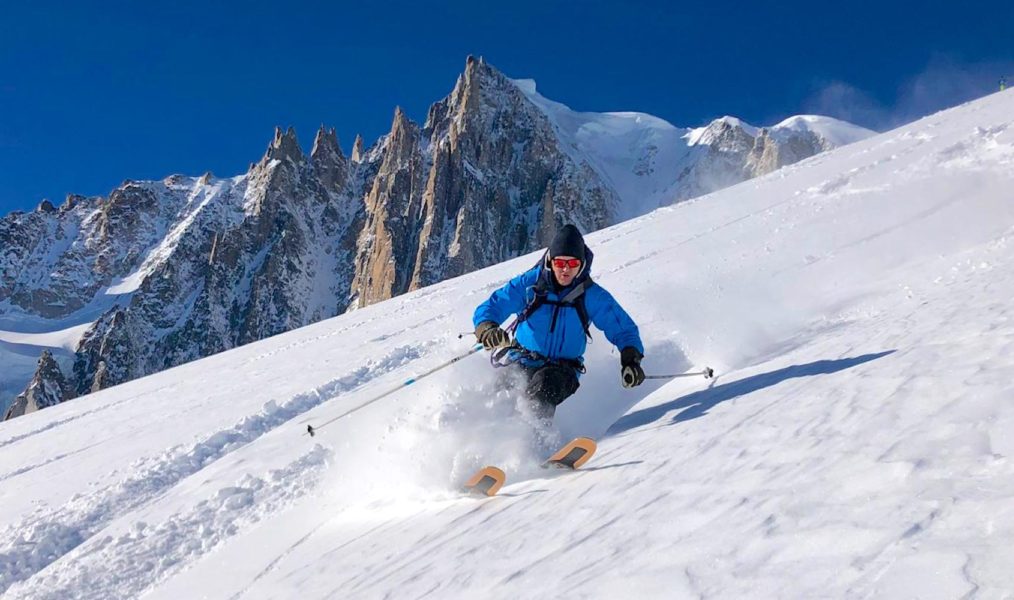After labelling 2018 as a black year for Chamonix in my previous blog post, there was a collective sense of nerves as the winter season approached. The snow didn’t arrive. Christmas came and went. Then New Year week came and went. The snow still didn’t come. What snow there was on the ground, was as hard as concrete. Once the New Year groups were safely on their way, then the snow really came. Last week it just kept falling, and falling, and falling. There was a huge depth of unconsolidated, deep powder. I can just imagine the gasps of relief in the tourist office and town hall.
This past week has been wall-to-wall sun, which is transforming the snow to be better consolidated, but the powder is glorious. Town is different. It’s quieter, not due to less visitors, but because people are tucked up in bed early each evening, after yet another epic day in the mountains. Chamonix has dusted the past year off its crown, and has risen gloriously from the ashes. Skiers walk through town with tired heavy legs, and rosy happy faces. Climbers descent after each day, with the kit jangling on their harnesses. The beating heart of Chamonix is back.
So what of the cable cars and breakdowns of the end of season? Strangely it’s not affected things as much as you’d imagine. For sure it seems quieter in ski areas such as the Grands Montets, but it’s made it better in many ways. It’s not completely tracked out within hours of opening after fresh snow, and for those who choose to earn their turns, it’s a quick skin up from Bochard to the Grands Montets itself. The visitor and seasonnaire numbers just aren’t there. Perhaps many people have been put off by the news at the end of last year, maybe UK visitors are put off by the never ending political concerns over the ‘B’ word, potentially there are less season workers due to visitor numbers being lower.
The net effect is that it’s quiet in town, and the off piste and touring routes are uncrowded. It’s brilliant. There’s no queues for the lift for skiing the Vallée Blanche, no queues for people buying tickets, and even parking in the valley is easier than usual. Don’t get me wrong, I’m not complaining at all. The cable car issues roll on unabated, with the main wheel bearings of the Planpraz cable car being cracked and needing replacement, and recently the Cornu lift closing several days for repairs. The cable car company is working hard to rectify these issues quickly, but ongoing repairs and break downs like this don’t help the image of the resort one iota.
Ice climbers aren’t having the best year, after the warm and very wet autumn, followed by a drought over the Christmas and New Year period, meaning that ice lines weren’t being well fed with water when the temperatures dropped, so the ice that’s formed is thinner than usual. In addition, the huge snowfalls of last week suddenly made access and egress from ice routes all the more difficult. The situation over in Italy is even more bizarre, with far less snowfall than the French side of the massif. This created a series of rescues in some ice climbing areas such as Val de Cogne, with climbers ascending routes such as Cold Couloir, and descending the snow in the upper section, to find it run out, and themselves blocked on bare rock slabs. Fortunately no-one came to harm.
On the Chamonix side, the ice is better, and the freeze thaw of this week has bulked out the routes, and both the natural ice climbs, as well as the artificial in Berard and Contamines are in good nick too. For ice climbing, this year is going to be a slow starter, but it’s getting there now. Usually I associate mid January with very cold and clear conditions, under an Alpine anti-cyclone, where ice conditions are epic. This hasn’t occurred this year, but it’s relatively cold now, and ice routes will build up bit by bit. Ice is always a game of chasing the ephemeral, and whilst the early season was delicate, the ice is getting better and better. It’ll be a year when the patient reap the rewards.
There is good news for lovers of skimo, with the Chamonix valley now boasting three designated and fully marked skinning tracks. These vary between 701m and 841m in vertical gain, so are a good elevation for those who like a quick uphill beasting. The three tracks are situated in Les Houches and the Grands Montets, with the new track at Le Tour. In addition the home run pistes at La Flégère and Brévent are open to ski tourers until 20:00 each day. These are important developments, as there was a rise in numbers of people skinning up pistes while they were being groomed, risking their safety skiing into piste basher cables. The new skin track, and open home runs until 20:00 give ample opportunity for people to get their vertical kicks in total safety.
After you’ve finished your day in the mountains, if you’ve still got any energy, the legendary Folie Douce has arrived in Chamonix. They’ve taken over the huge Club Med hotel on the Savoy pistes behind the Chamonix church and Maison de Montagne, and dusted it with much needed Folie magic. They’ve transformed the interior with a futuristic industrial look, light and stage shows, and it’s the biggest and best location for aprés-ski. Folie has given the Chamonix night life a real, and some might say much needed, shake-up. Certainly some bars seem a lot quieter than usual.
Back to the mountains, the ongoing dramas of Mont Blanc and the booking of the Gouter refuge continue unabated. After a few booking releases for mountain guides, the local prefecture has just written to the Club Alpin Français, imposing yet another new system where all future bookings are to be made with the full identities of those clients and guides for each booking. The opening of reservations scheduled on 15 January was suddenly postponed. There’s two sides to this development, with the positive being that it encourages clients wishing to ascend Mont Blanc to book early to start their preparations at that time to provide them the best chances of success.
The negative side is that this proposition is a further erosion of liberties and flexibility in the mountains, and a move to complete regulation completely against the spirit of mountaineering. It is imposing a completely inflexible bureaucratic system, onto a mountain environment that for safety reasons must allow some flexibility for the benefit of all mountain users. I fear the net effect is that the new system will encourage people to take more risks, ignoring the conditions on the mountains, as they fear complete immobility of their reservation. These moves benefit no one. Applying strict commercial practice to fluid mountain conditions, will end in tragedy. It is sad to watch this happen. Mont Blanc is a beautiful mountain, with the snow ridge above the Vallot, being one of the most spectacular arêtes in the Alps.
Over the past couple of weeks, one of the fringe sports of winter, snowshoeing, has profited from the unstable weather and huge snowfalls. While the avalanche risks were 4/5, and the snow just would not keep falling, many skiers hid their heads in their hands whilst watching the closures or limited openings of ski areas each day, yet the snowshoers headed out each day taking advantage of the exceptional conditions. Flexibility was key, as roads became impassible, and the avalanche risks evolved hour by hour. It was the perfect mountain activity for the conditions, and there were some amazing powder stashes found in breaks in the weather.
There’s been plenty of sad news in the mountains too, with a plane colliding with a helicopter near La Thuile, and a fatal avalanche in the Val Veny above Courmayeur. Last year popular BMG guide, and Glenmore Lodge instructor, Dave Hollinger suffered a brain stem stroke after a ski fall. His recovery is slow but inspiring, and anyone who has climbed or skied with Dave can read more here; https://www.gofundme.com/
So in summary, winter is fully back on track in Chamonix and the Mont Blanc massif. There’s great snow conditions out there to enjoy at the moment, and the ice climbing is improving day on day. The disaster of the Lognan cable car station burning down in September, hasn’t proved to be as influential as it might have been. In fact, I’ve heard from a few people that they prefer the Grands Montets with less crowds. The off piste on classics like the Vallée Blanche is in brilliant conditions, with great snow cover over the crevasses. Chamonix has risen like a snowy white phoenix from the ashes. It proves that the mountains stand greater than all, and that we must adapt to respect them and the prevailing conditions.
 Kingsley Jones is an International Mountain Leader and co-owner of Icicle Mountaineering. He’s also an author of mountain running books including ‘Lake District Trail & Fell Running’ and ‘Chamonix Trail Running’. More info at www.kingsleyjones.com
Kingsley Jones is an International Mountain Leader and co-owner of Icicle Mountaineering. He’s also an author of mountain running books including ‘Lake District Trail & Fell Running’ and ‘Chamonix Trail Running’. More info at www.kingsleyjones.com






